View Item
- xmlui.general.dspace_homeCentros Regionales y EEAsCentro Regional Entre RíosEEA ParanáArtículos científicosxmlui.ArtifactBrowser.ItemViewer.trail
- DSpace Home
- Centros Regionales y EEAs
- Centro Regional Entre Ríos
- EEA Paraná
- Artículos científicos
- View Item
Antifungal and toxicological evaluation of the alkaloids fraction from Neltuma nigra leaves
Abstract
The use of synthetic fungicides for control soybean crop diseases has been cuestionated because of its impacts on human health and the environment. This work evaluated the composition, antifungal activity and toxicity of the alkaloids fraction obtained from Neltuma nigra leaves and compared its effect with the fungicide difenoconazole on Sclerotium rolfsii, Cercospora kikuchii, and C. sojina. Alkaloids fraction was extracted from leaves of N. nigra and
[ver mas...]
The use of synthetic fungicides for control soybean crop diseases has been cuestionated because of its impacts on human health and the environment. This work evaluated the composition, antifungal activity and toxicity of the alkaloids fraction obtained from Neltuma nigra leaves and compared its effect with the fungicide difenoconazole on Sclerotium rolfsii, Cercospora kikuchii, and C. sojina. Alkaloids fraction was extracted from leaves of N. nigra and its composition was analyzed by gas-chromatography coupled to mass spectrometry (GC-MS). The antifungal effect was recorded by measuring diameters of halos of inhibition of the growth of the different evaluated fungis. The toxicity of the alkaloids fraction was carried out using the method of Caenorhabditis elegans toxicity test. The extracted alkaloids fraction contained the alkaloids tryptamine (63.9%), tetrahydroxyharman (13.8%), phenethylamine (11.1%), cassine (10.4%), and N-formylphenylethylamine (0.8%). The alkaloids fraction was as effective against S. rolfsii as on the Cercospora strains, with minimum inhibitory doses of 25.0 μg disc-1 and inhibitory halos in the range of 8.5-13.0 mm, while difenoconazole had no effect on S. rolfsii. The toxicity of the alkaloid fraction (30.4-68.8 mg L-1) and difenoconazole (0.1-2.8 mg L-1) was tested on the reproduction, body length, and fertility of C. elegans. The fraction reduced the reproductive rate by 28.8-72.4% whereas difenoconazole did it from 12.2% to complete suppression. Neither of them affected the fertility of C. elegans. These findings suggest that the alkaloids fraction of N. nigra leaves is less toxic than difenoconazole and is a promising botanical fungicide against pathogenic soybean fungi.
[Cerrar]

Author
Sequin, Christian J.;
Appelhans, Stefania Carolina;
Heis, Magalí S.;
Torrent, Walter A.;
Trossero, Julia A.;
Catalan, Cesar Atilio Nazareno;
Sampietro, Diego Alejandro;
Aceñolaza, Pablo Gilberto;
Fuente
Biocatalysis and Agricultural Biotechnology 54 : 102914. (November 2023)
Date
2023-11
Editorial
Elsevier
ISSN
1878-8181
Formato
pdf
Tipo de documento
artículo
Palabras Claves
Derechos de acceso
Restringido
 Excepto donde se diga explicitamente, este item se publica bajo la siguiente descripción: Creative Commons Attribution-NonCommercial-ShareAlike 2.5 Unported (CC BY-NC-SA 2.5)
Excepto donde se diga explicitamente, este item se publica bajo la siguiente descripción: Creative Commons Attribution-NonCommercial-ShareAlike 2.5 Unported (CC BY-NC-SA 2.5)


